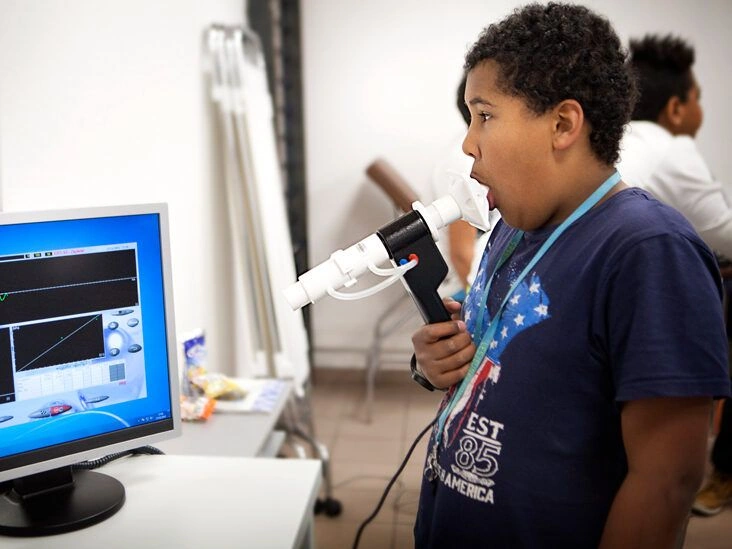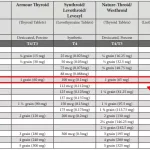Peak flow meters are compact instruments that are simple to operate at home, at school, or when traveling. They assess how forcefully a person can exhale air from the lungs.
If you have a breathing disorder such as asthma or chronic obstructive pulmonary disease (COPD), your clinician might suggest incorporating a peak flow meter into your treatment plan.
What is a peak flow meter used for?
They’re most often used by people with asthma to measure peak expiratory flow rate (PEFR), commonly called peak flow. PEFR represents the greatest speed at which you can blow air out of your lungs.
Your provider may advise using a peak flow meter each day or several times daily as part of a tailored asthma action plan to monitor symptoms.
A peak flow meter has a mouthpiece you blow into with one strong breath. The device registers the force of the exhalation in liters per minute (L/m). A marker on the meter shifts in response to the strength of your breath, landing on a numbered scale.
Regularly using a peak flow meter helps you monitor how well asthma is controlled and can indicate changes in respiratory conditions such as COPD.
Recording your measurements can show that asthma is deteriorating or that a flare-up is imminent. Falling numbers can warn that your airways are narrowing before you notice symptoms.
A peak flow meter can also assist you and your clinician in determining whether your current treatment is working or needs adjustment.

Healthline’s picks for the best peak flow meters
Microlife PF100 Digital Peak Flow & FEV1 Meter

- Price: $$$
As with other digital devices, this meter measures both PEFR and FEV1.
It can store up to 240 measurements, each with a date and time stamp. The device automatically records your highest readings, so you don’t need to do that manually. A risk indicator notifies you when you’re in the yellow or red zone.
The device includes batteries and a protective carrying case.
Some reviewers report that customer support from the manufacturer can be slow and that the included software is hard to use and not compatible with Macs.
SHOP NOW AT AMAZONOmron PF9940 PeakAir Peak Flow Meter

- Price: $
This lightweight, portable mechanical meter features adjustable green, yellow, and red zone markers. As with all mechanical meters, you’ll need to keep a written log or chart of your results.
The mouthpiece detaches for handwashing.
Many users say the meter is simple to operate and accurate, though some reviewers note it can be delicate and prone to breaking.
SHOP NOW AT AMAZONPhilips Respironics Peak Flow Meter

- Price: $$
This mechanical meter includes an integrated handle for easier handling. Its measurement span ranges from 60 L/m to 810 L/m.
A green/yellow and a yellow/red zone lever allow you to set personalized minimum and maximum airflow thresholds for simple indication during measurements.
Editor’s note: At the time of the latest publication, Philips Respironics Peak Flow Meter is not available on Amazon.It can be purchased from CVS.
SHOP NOW AT CVSSHOP NOW AT AMAZONMini-Wright Standard Range Peak Flow Meter

- Price: $$
This mechanical device measures from 60 L/m to 880 L/m. It has a built-in one-way valve that prevents inhaling through the device, helping ensure accurate measurements.
The meter is supplied with a diary for recording measurements easily.
It supports disposable mouthpieces, making it suitable for use by multiple people. If shared, clean the device between users.
The product includes a 100% money-back guarantee and a 1-year limited manufacturer warranty. The maker advises replacement every 3 years for single users, and more frequently if used by multiple people.
SHOP NOW AT NATIONAL ALLERGYMini-Wright AFS Low Range Peak Flow Meter

- Price: $$
This mechanical peak flow meter is intended for people who cannot achieve high PEFR values. It reads from 30 L/m to 400 L/m. You can use it on its own or alongside a standard meter.
It features a one-way valve and can accept disposable mouthpieces.
The meter includes a 100% money-back guarantee and a 1-year limited warranty. The manufacturer suggests replacing it every 3 years.
SHOP NOW AT NATIONAL ALLERGYHow to use a peak flow meter
Because peak flow meters vary by type and brand, read and follow the specific instructions included with your device. Generally, here’s what to expect when using one:

Take three readings
Typically, use the meter as follows:
- If possible, stand up straight.
- Ensure the peak flow meter’s marker is at the bottom of the scale.
- Hold the meter by its handle. Inhale as deeply as you can.
- Seal your lips tightly around the mouthpiece.
- Keep your tongue down and blow out one long, forceful breath as quickly as possible.
- The meter’s marker will rise to a number — that’s your reading.
- After recording the first reading, repeat the procedure two more times. Reset the marker to the bottom before each attempt.
Keep a record of all readings
Record the highest of the three readings, along with the date, time, and any notable details. Some meters include a chart or graph for logging values.
You can also jot readings down manually in a notebook.
Follow your clinician’s directions about exercise and medication based on your readings.
When to use a peak flow meter
- When asthma is well controlled: If your asthma is stable, you may only use your peak flow meter when symptoms increase or you encounter triggers like cold, dry air.
- When getting symptoms under control: If asthma is not well controlled, you may take readings at least once daily at the same time each day, or several times daily (for example, morning and bedtime).
- When symptoms occur: Use the meter when symptoms develop, such as symptoms that wake you during the night or occur at predictable times.
- If you have an acute respiratory illness: During a cold, flu, or other respiratory infection, you may check your peak flow more frequently.
- With your medications: Your provider might advise using the meter immediately before and after taking medications like a rescue inhaler (inhaled albuterol).
Where can you get peak flow meters?
Peak flow meters are generally inexpensive and don’t need a prescription. They’re widely sold online and in stores, from retailers or directly from manufacturers.
You can buy a peak flow meter at local drugstores such as Walgreens or CVS. Pharmacies and medical supply shops often stock them as well.
SHOP NOW AT WALGREENSSHOP NOW AT CVSUnderstanding your peak flow rate
When you first start with a peak flow meter, your clinician may suggest using it multiple times daily for 2 to 3 weeks. This helps establish baseline values and your personal best peak flow.
Your personal best is the highest reading you record during that period. It’s important because it reflects how well you breathe when your airways are clear and symptom-free.
To determine your personal best, your clinician will have you use the meter at least twice a day, perhaps first thing in the morning before medication and again in the afternoon or evening.
Knowing your personal best is crucial for asthma control. Changes in this number can signal worsening disease or the need to alter treatment.
After identifying your personal best, you and your clinician can create a plan for using the meter and interpreting its data, including defining your personal peak flow zones.
Peak flow zones correspond to specific numeric ranges based on your personal peak flow. When you take measurements, compare them with your zone numbers to determine which zone you’re in.
When to see a doctorSeek immediate medical attention for signs of a severe asthma attack.
These can include:
- very shortness of breath
- inability to speak more than brief sentences
- wheezing
- using neck or chest muscles to breathe
- no improvement after using a rescue inhaler
Frequently asked questions
Can my young child use a peak flow meter?
Children around 4 or 5 years old may be able to use a peak flow meter if they’re at least 43 inches tall.
Peak flow meters are used alongside peak flow rate charts or calculators. These charts estimate peak flow zones, helping determine whether a child falls into the green, yellow, or red zone.
Peak flow charts typically begin at 43 inches. If your child is shorter, discuss meter use and alternatives with their pediatrician.
Can a peak flow meter help me identify asthma triggers in my environment?
Yes. Keeping a log of readings can help pinpoint triggers that worsen asthma. Maintaining a timed diary of potential exposures and daily activities can clarify what might provoke attacks.
Do I need to wash my peak flow meter regularly?
Yes. A dirty meter can harbor germs and bacteria.
Clean the device with mild soap and warm water. Some models can be washed on the top rack of a dishwasher. Ensure the meter is completely dry before using it again.
The takeaway
You and your clinician will have a plan for each zone. If a reading falls in the red zone, contact your clinician and get immediate medical help. Readings in the yellow zone may also require medical attention.


















Leave a Reply
You must be logged in to post a comment.